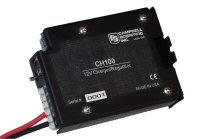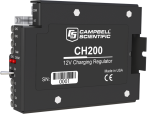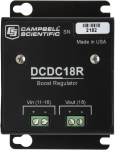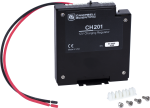This product is not available for new orders. We recommend ordering: CH150.

| Services Available |
|---|
Überblick
Der CH100 ist ein Laderegler für 12V Batterien. Er verfügt über eigebaute Temperaturkompensation um die Batterieleistung zu optimieren. Er wird normalerweise eingesetzt, wenn eine wiederaufladbare Batterie verwendet werden soll und die PS100 oder PS12LA mit 7Ah sind nicht ausreichend.
Lesen Sie mehrBilder










3D/CAD-Dateien:
Technische Beschreibung
The CH100 regulator connects the BP12, BP24, or other sealed rechargeable battery to an external charging source (e.g., solar panel, wall charger). The circuitry of the CH100 is similar to the PS100, but the CH100 does not include a rechargeable battery. The rechargeable battery must be capable of accepting recharge from a trickle-charge source.
The CH100 controls the current flowing to the battery and prevents the battery current from flowing to the charging source.
Kompatibel mit
Please note: The following shows notable compatibility information. It is not a comprehensive list of all compatible products.
Miscellaneous
| Product | Compatible | Note |
|---|---|---|
| 34029 |
Additional Compatibility Information
Batteries
The CH100 is typically used with the BP12 and BP24 battery packs.
Spezifikationen
| input Voltage (CHG Terminals) | 15 to 28 Vdc or 18 Vac RMS |
| Charging Output Voltage | Temperature-compensated float charge (for 12 Vdc battery) |
| Charging Current Limit | 1.2 A (typical) |
| Power Out (+12 Terminals) Voltage | Unregulated 12 Vdc from battery |
| Length of Red and Black Wires | ~30 cm (12 in.) |
| Dimensions | 10.2 x 7.0 x 3.9 cm (4.0 x 2.8 x 1.5 in.) |
| Weight | 158 g (5.5 oz) |
Quiescent Current |
|
| Charge Source Present | 3 to 5 mA |
| No Charge Source Present | 0 mA |
Dokumente
Broschüren Produkte
Technische Artikel
FAQs für
Number of FAQs related to CH100: 13
Alle anzeigenWenige anzeigen
-
When the current from a solar panel is pushed through long, small-diameter cables, there is a voltage drop generated across the copper cables. This can be minimized by using shorter cables, if possible, or by using cable with a larger diameter (large-gauge wire). Some customers have successfully installed panels up to 50 and 100 ft away.
-
No. The CH100 is designed to charge a 12 Vdc battery pack, not a 24 Vdc battery pack.
-
The CH100 has a built-in diode that only allows battery current to flow out of the battery to the 12 V and G terminals. But, because both loads are hooked up to the same battery, the system still drains the same. If there are two loads, and one is of a lesser priority than the other, the lower priority load can be controlled by connecting it to the SW12 on the datalogger and turning it off if the battery voltage starts to get too low.
-
No. The CH100 will limit the current coming in from the 30 W panel to approximately 1.2 A, but it should not damage the regulator.
-
Actually, the current flows up to the maximum amount of amperage based on whether the battery will take the charge or not. The internal resistance of a lead-acid battery increases as it reaches a full charge. The charger/regulator must perform two operations when charging a battery:
- Give the battery all the current it will take when it is in a discharged state.
- Limit the voltage across the battery to a set value based on temperature when the battery reaches a full charge so as not to overcharge the battery.
The voltage rises as the voltage in the battery rises. When the battery voltage rises up close to the voltage limit of the charger, the voltage of the regulator is limited. This causes the battery to take less and less charge (less amperage) because the voltage of the battery and the regulator get to be so close that no more current can be forced into the battery.
-
Not quite. The PS24 consists of a 24 Ah battery, a CH100 regulator, and a 10 by 12 in. environmental enclosure. Aside from the enclosure, the PS24 is very similar to a BP24 combined with a CH100.
-
The CH100 Charge Controller is designed to work with maintenance-free deep-cycle lead-acid batteries. The voltage of the charger is slightly different than what is required to charge the marine-type flooded-cell battery. Therefore, Campbell Scientific recommends purchasing a deep-cycle battery, such as the BP12 or BP24, rather than a flooded-cell battery. Note that our regulated solar panels, such as the SP20R and SP10R, are intended to be used with, and connected directly to, a user-supplied flooded battery.
-
With a solar panel connected, the quiescent current should be less than a 3 mA draw on the solar panel to light up the LED. (It does not consume current from the battery.) At night, the blocking diode blocks all measurable current from the battery. For power budget calculations, use 0 mA for the CH100 or PS100.
-
The red LED light on the CH100 or PS100 comes on whenever there is a working charging source connected. For example, if a solar panel is connected to the device, and the sun is shining, the LED light will turn on until the sun starts to go down. The red LED light should always be on when the device is connected to the wall transformer (when the ac power is present). Thus, the LED light is only a confirmation of power available to charge the battery.
If it is desirable to have an indication that the power switch is on, an LED light can be added to an unused control port on the datalogger and a program can be written to cause the LED light to blink every few seconds. Blinking the LED light once every few seconds will not put a large load on the battery, whereas a continuously lit LED draws down the battery more quickly.
-
The BP24 should never be connected directly to an unregulated solar panel. A voltage regulator, such as the CH100, must be included in the circuit, or damage to the battery will occur.
Anwendungsbeispiele
Currently, the Andean tropical glaciers are in an accelerated process of retreat. These glaciers are......lesen Sie mehr





